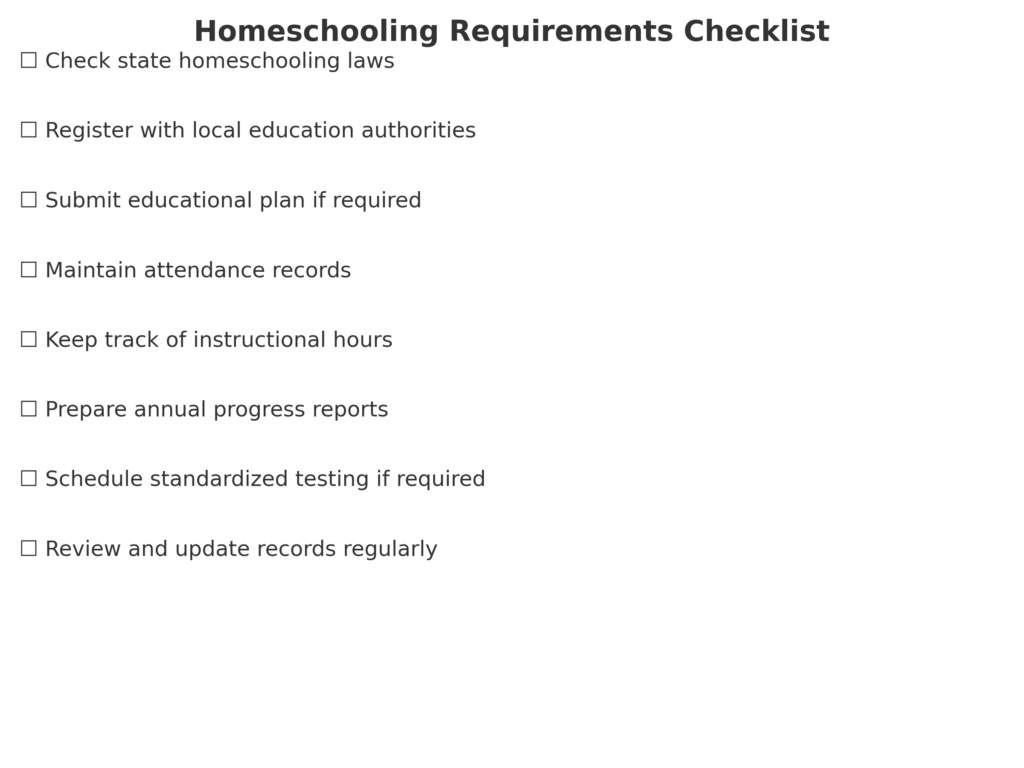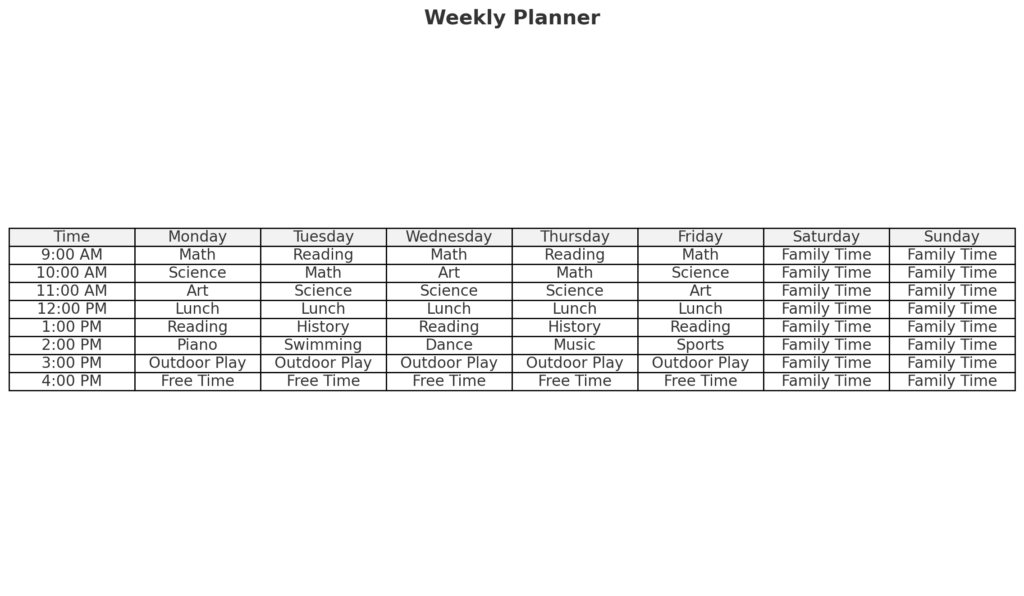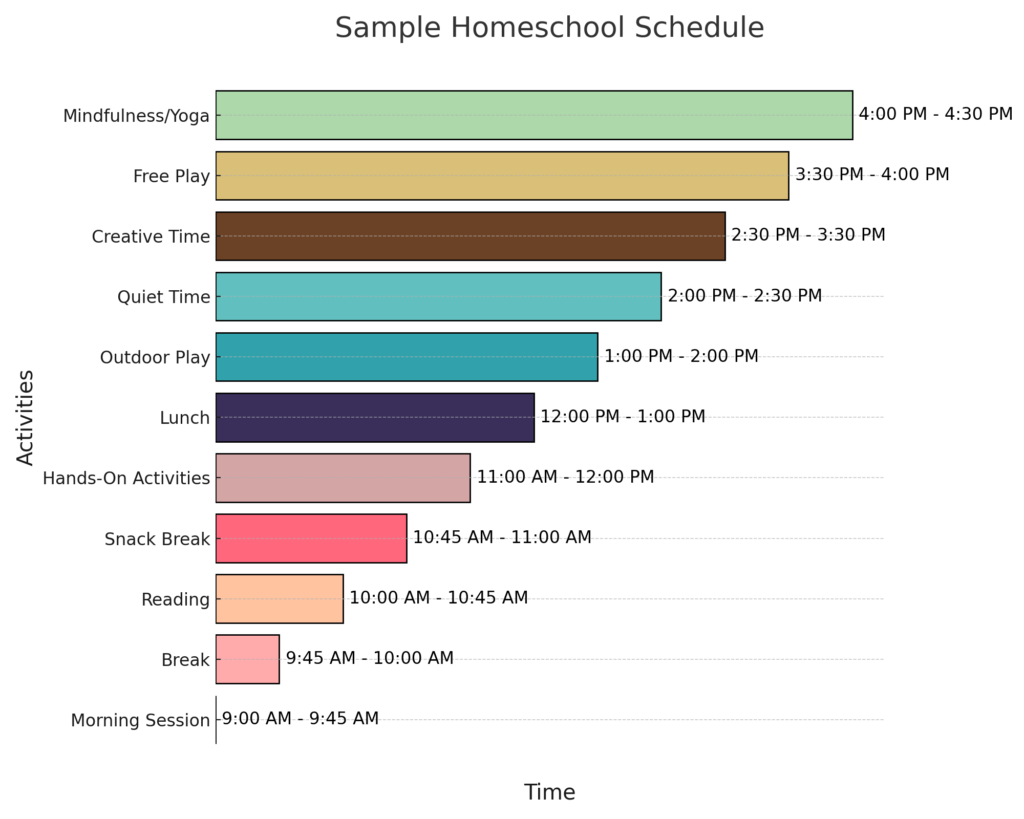Homeschooling is a fantastic way to tailor education to your child’s unique needs, but finding the right balance of homeschool hours can be a challenge. Planning a flexible homeschool schedule that works for your family is key to ensuring a successful learning experience.
In this article, we’ll explore various aspects of homeschool hours, from planning and customizing schedules to incorporating life skills and technology. We’ll also discuss the importance of balancing learning activities and socialization to create a well-rounded homeschool routine. Whether you’re just starting out or looking to improve your current schedule, these tips will help you make the most of your homeschooling journey.
READ- Homeschool Co-ops: Benefits, Costs, Starting, and More
Planning for Homeschooling Hours: Things to Consider
Planning homeschool hours is a crucial step in ensuring a successful and enjoyable homeschooling experience for your child. It helps you stay organized and ensures that your child is meeting their educational goals. Here are some key things to consider when planning your homeschool hours:
1. Family Lifestyle
Every family has a unique lifestyle that can influence how you plan your homeschool hours. Consider your daily routines, work schedules, and other commitments. For example, if both parents work from home, you might need to create a flexible schedule that allows you to balance work and homeschooling.
Case Study: The Johnson family has two parents who work from home. They start their homeschool day at 9 AM and take a long lunch break so everyone can relax. In the afternoon, the kids do independent work while the parents focus on their jobs. This flexible schedule helps them balance work and learning.
2. Educational Goals
Think about what you want your child to achieve during the homeschooling year. Do you have specific academic goals, like improving reading skills or mastering multiplication? Or perhaps you have broader goals, like fostering a love of learning or developing critical thinking skills. Setting clear goals will help you determine how much time to spend on each subject.
TIP: Write down your educational goals at the beginning of the school year. Review them regularly to make sure your homeschool hours are aligned with these goals.
3. State Regulations
Different states have different laws and regulations for homeschooling. Some states require a certain number of hours or days of instruction each year. Make sure you understand the homeschooling laws in your state to ensure you are meeting the requirements.

4. Child’s Age and Learning Style
Younger children typically need shorter, more frequent breaks and a lot of hands-on activities. Older children can handle longer periods of focused work. Also, consider your child’s learning style. Some kids learn best through visual aids, while others prefer listening or hands-on activities.
Case Study: Emily, a 7-year-old visual learner, loves using colorful charts and videos to understand new concepts. Her mom, Sarah, includes plenty of visual resources in their homeschool hours, which helps Emily stay engaged and excited about learning.
5. Flexibility and Adjustments
One of the great benefits of homeschooling is the ability to be flexible. If something isn’t working, don’t be afraid to change it. Adjust your schedule as needed to better fit your child’s needs and interests.
TIP: It’s okay to have a schedule that changes. Some days might be more structured, while others are more relaxed. Flexibility allows you to make learning fun and responsive to your child’s needs.
6. Extracurricular Activities
Incorporate extracurricular activities into your homeschool schedule. These activities, such as sports, music lessons, or art classes, are important for your child’s overall development and can provide a break from academic work.

Considering these factors, you can create a homeschooling schedule that works well for your family. Planning homeschool hours thoughtfully ensures that your child receives a well-rounded education while allowing for flexibility and fun.
Customizing Homeschool Hours for Your Child
Every child is unique, and their homeschool hours should be too! This is one of the biggest advantages of homeschooling. Unlike traditional schools with fixed schedules, you have the flexibility to design a schedule that best suits your child’s needs. Here’s how you can do it.
Understanding Your Child’s Learning Pace
Children learn at different speeds. Some kids grasp new concepts quickly, while others need more time to fully understand. When you’re homeschooling, you can adjust the hours to match your child’s learning pace. For instance, if your child needs extra time to understand math but breezes through reading, you can spend more time on math and less on reading.
Case Study: Jenny is a 7-year-old who loves stories but finds math challenging. Her mom noticed this and decided to adjust their schedule. They now spend an extra 30 minutes on math each day and use fun, story-based math problems to make it more engaging. This way, Jenny gets the help she needs without feeling overwhelmed.
Considering Interests and Passions
Another great thing about homeschooling is that you can incorporate your child’s interests into their learning. If your child loves animals, you can include more science lessons about wildlife, or if they enjoy art, you can add more creative projects into the mix.
Insight: Engaging your child’s passions can make learning more enjoyable and meaningful. When kids are interested in what they’re learning, they are more motivated and retain information better.
Balancing Extracurricular Activities
Extracurricular activities are just as important as academic lessons. Activities like sports, music, and art help children develop new skills and passions. When planning your homeschool hours, make sure to include time for these activities.
Case Study: Tom is a 9-year-old who loves playing the piano. His parents decided to include piano practice in their daily schedule. They start their day with academic lessons in the morning and dedicate an hour after lunch for piano practice. This routine helps Tom stay focused on his studies and enjoy his music without feeling rushed.
Flexible Homeschool Hours
Flexibility is one of the biggest perks of homeschooling. If your child is having a tough day or if something unexpected comes up, you can easily adjust the schedule. You might shorten the lessons or switch to a more hands-on activity that day.
Insight: Being flexible helps reduce stress for both you and your child. It also teaches kids how to adapt to changes, an important life skill.
Incorporating Breaks and Rest
Kids need breaks just like adults do. Make sure to include short breaks between lessons and longer breaks for meals and play. These breaks help children stay focused and energized throughout the day.
Imagine a day that looks like this:
- 9:00 AM – 10:00 AM: Math Lesson
- 10:00 AM – 10:15 AM: Snack Break
- 10:15 AM – 11:15 AM: Reading Time
- 11:15 AM – 11:30 AM: Play Break
- 11:30 AM – 12:30 PM: Science Lesson
- 12:30 PM – 1:30 PM: Lunch and Rest
- 1:30 PM – 2:30 PM: Art Project
- 2:30 PM – 3:00 PM: Outdoor Play
Homeschooling for Different Learning Styles
Children have different learning styles: visual, auditory, kinesthetic, etc. Understanding your child’s learning style can help you customize their homeschool hours more effectively.
Visual Learners: Use charts, diagrams, and videos.
Auditory Learners: Incorporate read-alouds, discussions, and audio books.
Kinesthetic Learners: Include hands-on activities, experiments, and movement breaks.
Case Study: Sam is a kinesthetic learner who loves to move around. His parents noticed he learns best when he’s active, so they included lots of hands-on activities in his schedule. They use building blocks for math lessons and go on nature walks for science.
Creating a Homeschool Schedule that Works
Here’s a sample schedule to give you an idea of how to structure your day:
Sample Schedule:
- 9:00 AM – 9:30 AM: Morning Meeting (Plan the day)
- 9:30 AM – 10:30 AM: Math (Using visual aids)
- 10:30 AM – 10:45 AM: Break (Snack and play)
- 10:45 AM – 11:45 AM: Reading (With read-aloud and discussion)
- 11:45 AM – 12:00 PM: Break (Short rest)
- 12:00 PM – 1:00 PM: Science (Hands-on experiments)
- 1:00 PM – 2:00 PM: Lunch and Rest
- 2:00 PM – 3:00 PM: Art/Extracurricular Activity (Based on child’s interest)
Remember, this is just a guide. Feel free to adjust the times and activities to fit your child’s needs and interests.
Balancing Homeschool Hours and Learning Activities
Balancing homeschool hours with various learning activities is key to a successful and enjoyable homeschooling experience. A well-rounded homeschool routine includes structured lessons, hands-on activities, playtime, and rest. Here’s how to create that balance.
Structured Learning Time
Structured learning time is when kids focus on core subjects like math, reading, and science. This time is important for building foundational skills. Here’s a sample schedule for structured learning time:
- Morning Session (9:00 AM – 11:00 AM):
- Math (9:00 AM – 9:45 AM): Start the day with math problems and exercises.
- Break (9:45 AM – 10:00 AM): A short break to stretch and refresh.
- Reading (10:00 AM – 10:45 AM): Reading comprehension activities or silent reading time.
- Snack Break (10:45 AM – 11:00 AM): A healthy snack and some free time.
This structured approach helps kids stay focused and make steady progress in their studies.
Hands-On Activities
Hands-on activities are essential for reinforcing what kids learn during structured lessons. These activities can include science experiments, art projects, cooking, and more. Here’s how you can integrate them:
- Science Experiments: Conduct simple experiments that relate to the lessons. For example, if you’re learning about plants, you can plant seeds and observe their growth.
- Art Projects: Use art to explore different cultures or historical events. If you’re studying ancient Egypt, you can create paper mache pyramids.
- Cooking: Cooking teaches math (measuring ingredients), science (chemical reactions), and life skills. You can cook a meal together that relates to a geography lesson about another country.
Case Study:
The Johnson Family found that incorporating hands-on activities dramatically improved their children’s retention of information. After learning about fractions in math, they baked a cake together, using fractions to measure ingredients. Their kids understood fractions much better after this tasty lesson!
Playtime and Physical Activity
Playtime is crucial for children’s development. It allows them to use their imagination, develop social skills, and stay active. Make sure to include time for play and physical activities in your homeschool schedule:
- Outdoor Play: Schedule time for outdoor activities like playing in the park, riding bikes, or even a nature walk. Fresh air and exercise help kids stay healthy and focused.
- Indoor Games: On rainy days, play indoor games like board games, puzzles, or building with blocks. These activities can also be educational and promote critical thinking.
Insight:
According to the American Academy of Pediatrics, children should get at least 60 minutes of physical activity each day. This can be broken into shorter periods, making it easy to fit into your homeschool day.
Rest and Relaxation
Rest is just as important as active learning. Short breaks throughout the day help kids recharge and stay focused. Here’s how to incorporate rest into your schedule:
- Quiet Time: After lunch, have a quiet time where kids can read, nap, or engage in a quiet activity like drawing. This helps them relax and prepares them for the afternoon.
- Mindfulness Activities: Practice mindfulness or simple yoga exercises. These activities can reduce stress and improve concentration.

By balancing structured learning time, hands-on activities, playtime, and rest, you create a well-rounded homeschool routine that keeps your child engaged and happy. Remember, every family is different, so adjust the schedule to fit your unique needs and enjoy the homeschooling journey!

Nawab is an experienced educator with a decade of teaching across preschool to K-12 levels. Holding both a graduate degree and a diploma in elementary education, he is passionate about fostering learning environments that inspire young minds. In addition to his teaching career, Nawab has been actively blogging and writing content for the past four years, sharing insights and resources for educators and parents alike.

3 thoughts on “Homeschool Hours by Age Chart: Guide For Parents”